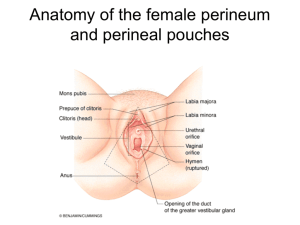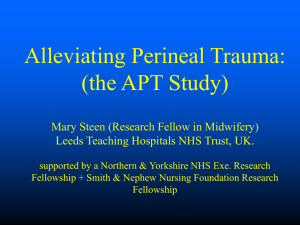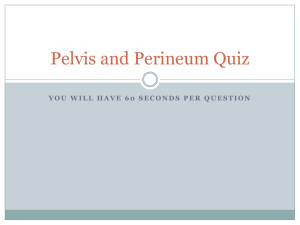Evidence Based Guidelines for Care of the Perineum
advertisement
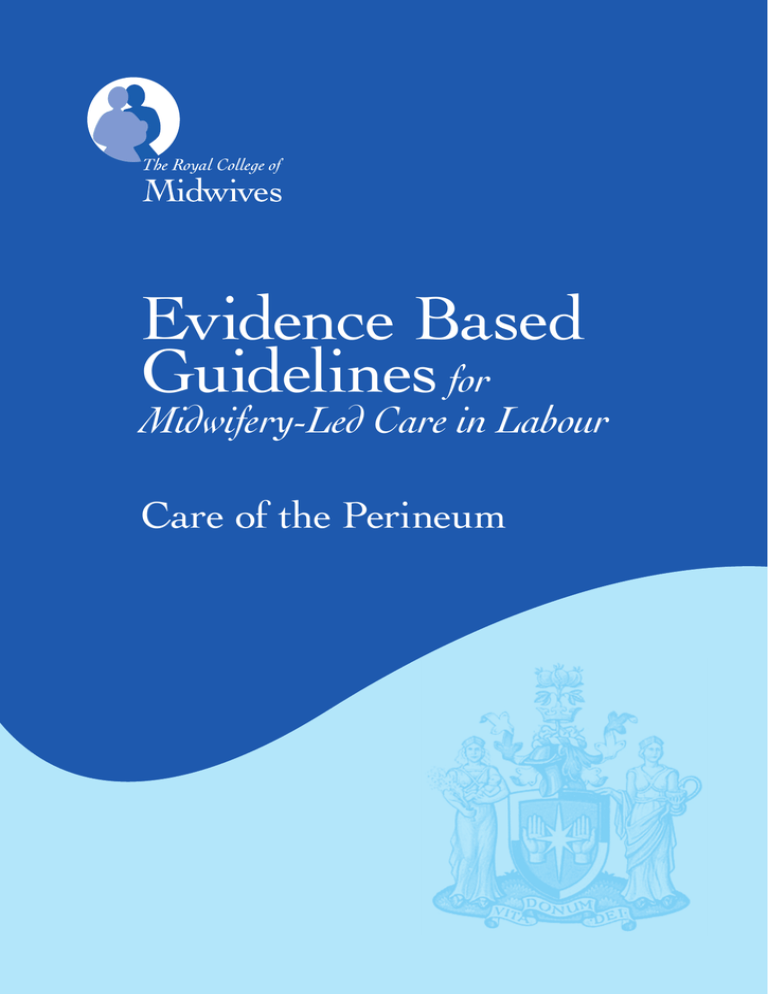
Evidence Based Guidelines for Midwifery-Led Care in Labour Care of the Perineum Antenatal perineal massage carried out by the mother or her partner in the third trimester is an effective approach to reduce perineal trauma among women who have not had a previous vaginal birth (Beckmann and Garrett 2006). Women should be offered the application of warm compresses in the second stage of labour as this may reduce perineal trauma and the intervention is acceptable to both women and midwives (Aasheim et al. 2011). Studies are inconclusive on using guidance or flexion of the presenting part with the aim of reducing perineal trauma (Aasheim et al. 2011; Pirhonen et al 1998; Myrfield 1997). NICE (2007) recommend that either the ‘hands on’ or the ‘hands poised’ technique can be used to facilitate spontaneous birth. There is no evidence of short-term or long-term maternal benefit to support the use of routine episiotomy (Carroli and Mignini 2009). Episiotomy has been associated with increased risk of severe perineal trauma (Dudding et al. 2008; Eason et al. 2000; Renfrew et al. 1998; Albers et al. 1999). 2 Evidence Based Guidelines for Midwifery-Led Care in Labour ©The Royal College of Midwives 2012 Care of the Perineum Practice Points The majority of women who have a vaginal birth will sustain perineal trauma from a spontaneous perineal tear or episiotomy or both. An overall perineal trauma rate of 85% was reported by Albers et al. (2005). Perineal trauma is highly associated with perineal pain and dyspareunia, with perineal pain being one of the most commonly reported symptoms in the postnatal period (Macarthur and Macarthur 2004), and a symptom which may persist (McCandlish et al. 1998). Other risk factors for perineal pain include mode of birth and primiparity. These factors are all highly inter-related so care has to be taken when reporting on the independent effects of each. There is some evidence to suggest that the severity of the perineal injury is linked to the severity of perineal pain (Macarthur and Macarthur 2004). Studies have compared interventions to prevent perineal trauma at birth with usual care antenatally and during the second stage of labour. Some risk factors for more severe perineal trauma (third and fourth degree tears), for example, ethnicity, parity and infant birth weight (Groutz et al. 2011) may not be amenable to intervention. The Cochrane review comparing perineal digital massage during pregnancy with usual care (Beckman and Garrett 2006) found an association with an overall reduction in the incidence of perineal trauma, and women who implemented the intervention were less likely to have an episiotomy. There were no differences in incidence of degree of perineal trauma, incidence of instrumental births, sexual satisfaction, urinary or faecal incontinence. Women having a first vaginal birth were statistically significantly less likely to have perineal pain at three months post-birth. With respect to the second stage of labour, several studies have assessed the outcome of interventions including perineal massage (Stamp 2001), perineal guarding (McCandlish 1998; Mayerhofer 2002), active pushing in second stage labour with or without epidural analgesia (Brancato et al. 2007; Bloom et al. 2006), maternal position for the birth among women who did not have epidural analgesia (Gupta et al. 2004) and warm compresses applied to the perineum (Dahlen et al. 2007). Stamp et al. (2001) conducted a trial to determine the effects of perineal massage during the second stage of labour. Findings showed that the intervention did not increase the likelihood of an intact perineum or reduce the risk of pain, dyspareunia, or urinary and faecal problems. NICE (2007) guidance is that perineal massage should not be performed in the second stage. McCandlish et al.’s (1998) trial, which recruited 5,316 women, compared two methods of management; ”hands on”, in which the midwife placed pressure on the baby’s head to support (“guard”) the perineum, with lateral flexion to facilitate delivery of the shoulders, and “hands poised”, in which the midwife kept her hands poised, not touching the perineum or fetal head and allowing spontaneous delivery of the shoulders. Women in the ‘hands poised’ group were more likely to report ‘mild’ perineal pain at 10 days postbirth. The only other statistically significant differences were in two secondary outcomes: episiotomy rates were lower in the ”hands poised” group, and manual removal of the placenta was more common. Mayerhofer et al.’s (2002) trial of 1,076 women also compared “hands on” and “hands poised”. Findings confirmed those of McCandlish et al. (1998) of no statistically significant differences in overall perineal injury, but an increased rate of episiotomy and third degree tear in the “hands on” group. NICE (2007) guidance is that either of these techniques could be used to facilitate spontaneous vaginal birth. 3 Evidence Based Guidelines for Midwifery-Led Care in Labour ©The Royal College of Midwives 2012 Care of the Perineum Care of the Perineum A Cochrane review (Gupta 2004) of positions during the second stage of labour among women who did not have epidural analgesia, found a reduction in use of episiotomy and an increase in second degree tears among women allocated to non-upright groups. The reviewers recommended that in the absence of robust evidence, women should be able to make informed choices about birth positions. This recommendation is supportive of current NICE guidance on positions for vaginal birth (NICE 2007). A randomised controlled trial which investigated perineal outcomes and maternal comfort following the application of warm compresses in the second stage for nulliparous women reported that use did not reduce the need for suturing but did reduce the risk of 3rd and 4th degree tears, with some evidence that warm packs reduced the severity of pain (Dahlen et al. 2007). Findings of a recent Cochrane review (described later) do support use of warm compression (Aasheim et al 2011). No formal evaluation of the use of cold packs during the 2nd stage of labour has been reported. A Cochrane review of cooling interventions applied to the perineum following birth, which included ice packs, cold gel pads and cool baths, found limited evidence of benefit (East et al. 2007). Other techniques to prevent perineal trauma include guiding or support techniques (Pirhonen et al. 1998; Myrfield 1997). These include Ritgen’s manoeuvre which claims to reduce perineal trauma by reducing the presenting diameter of the fetal head through the vaginal opening (Myrfield 1997). The flexion technique involves maintaining flexion of the emerging fetal head, by exerting pressure on the emerging occiput in a downwards direction towards the perineum, preventing extension until crowning and the guarding of the perineum by placing a hand against the perineum (Mayerhofer 2002; Myrfield 1997). Evidence is required of the benefit of these interventions on perineal trauma and other relevant outcomes. A recently published Cochrane review (Aasheim et al. 2011) assessed the effect of perineal techniques during the second stage of labour on incidence of perineal trauma. The reviewers found sufficient evidence to support the use of warm compresses to prevent perineal tears. Based on the outcomes of meta-analyses, there was a significant effect of the use of warm compresses compared with hands off or no warm compress on the incidence of third and fourthdegree tears. There was also a reduction in third and fourth degree tears with massage of the perineum versus ‘hands off’; and of ‘hands off’ the perineum versus ‘hands on’ to reduce the rate of episiotomy. The studies included had considerable clinical variation and the terms ‘hands on’, ‘hands off’, ‘standard care’ and ‘perineal support’ were not always defined sufficiently. Methodological quality varied. The reviewers concluded that women should be offered warm compresses as their use may reduce perineal trauma and the intervention is acceptable to both women and midwives. 4 Evidence Based Guidelines for Midwifery-Led Care in Labour ©The Royal College of Midwives 2012 Care of the Perineum Approaches to management of the passive and active phases of the second stage of labour have also been considered with respect to interventions to reduce perineal trauma. Bloom et al. (2006) conducted a trial of coached and uncoached pushing in the second stage of labour. Mean labour duration was significantly shorter for women in the coached group, with no differences in any other outcomes assessed, but the trial quality was poor. Brancato et al. (2007) conducted a meta-analyses of seven trials which had compared outcomes of passive descent and early pushing in women with effective epidural analgesia. There were no differences in rate of perineal laceration or performance of episiotomy. Current NICE guidance (2007) is that women should be advised that they should be guided by their own urges to push, as there is no high level evidence to support benefit of directed pushing during second stage including impact on perineal trauma. Episiotomy has been associated with increased risk of severe perineal trauma. A systematic review of incidence, risk factors and options for management of obstetric anal sphincter injury (Dudding et al. 2008) found episiotomy was strongly associated with a higher frequency of anal sphincter trauma. There was wide variation in reported incidence of anal sphincter trauma, with the review authors considering that the true incidence was around 11%. One study reported that when nulliparous women had either a midline or mediolateral episiotomy the perineal body length maybe an indicator of the occurrence of severe perineal lacerations and suggest a critical value of 3 cm (Ayton et al. 2005). Further evidence is needed to support this claim. Immersion in water during labour or birth was not associated with a reduction in perineal trauma in a Cochrane review which included 12 trials and data on 3243 women (Burns and Cluett 2009). Maternal outcomes associated with the model of maternity care received also demonstrate an impact on perineal trauma with women who received midwifery led care being less likely to have an episiotomy (Birthplace in England Collaborative Group 2011; Hatem et al. 2009). It is difficult to elicit the extent to which this is influenced by fewer operative births, the culture and context of care, the characteristics of women who may opt for one model of care over another, or the skills and competencies of the midwives working within the different models of care. 5 Evidence Based Guidelines for Midwifery-Led Care in Labour ©The Royal College of Midwives 2012 Care of the Perineum Another Cochrane review evaluated the risks and benefits of a policy of restrictive vs routine episiotomy and the benefits or detrimental effects of the use of mediolateral vs midline episiotomy (Carroli and Mignini 2009). Eight trials were included, with data on 5541 women. In the routine group, 75% of women had an episiotomy. There was a lower risk of posterior perineal trauma, need for suturing, and healing complications at 7 days post-birth with restrictive use of episiotomy. The reviewers concluded that evidence clearly supported restrictive use, with need for data on longer-term outcomes highlighted. Evidence is now needed to support which type of episiotomy incision should be used if this intervention is indicated (medio-lateral or midline). No trials were included in the review which had looked at outcomes of mediolateral compared with midline incisions because of poor methodological quality. Until further evidence is available, the approach used should be that most familiar to the clinician. Albers L, Garcia J, Renfrew M, et al. (1999) Distribution of genital tract trauma in childbirth and related perineal pain. Birth 26(1): 11-17 Albers LL, Sedler KD, Bedrick EJ, et al. (2005) Midwifery care measures in the second stage of labor and reduction of genital tract trauma at birth: a randomized trial. Journal of Midwifery & Women’s Health. 50(5): 365-72. Back Aasheim V, Nilsen ABV, Lukasse M, et al. (2011) Perineal techniques during the second stage of labour for reducing perineal trauma. Cochrane Database of Systematic Reviews, Issue 12. Chichester: John Wiley & Sons Ayton H, Tapisiz OL, Tuncay G, et al. (2005) Severe perineal lacerations in nulliparous women and episiotomy type. European Journal of Obstetrics & Gynecology. 121: 46-50. Beckmann MM, Garrett AJ (2006) Antenatal perineal massage for reducing perineal trauma. Cochrane Database of Systematic Reviews 2006, Issue 1. Chichester: John Wiley & Sons Bloom SL, Casey BM, Schaffer JL, et al (2006). A randomised trial of coached versus uncoached maternal pushing during the second stage of labor. American Journal of Obstetrics and Gynecology. 194(1): 10-13. Birthplace in England Collaborative Group (2011). Perinatal and maternal outcomes by planned place of birth for healthy women with low risk pregnancies: the Birthplace in England national prospective cohort study. British Medical Journal 343: d7400 doi: 10.1136/bmj.d7400. Open Access. Carroli G, Mignini L (2009) Episiotomy for vaginal birth. Cochrane Database of Systematic Reviews, Issue 1. Chichester: John Wiley & Sons Cluett ER, Burns E.(2009) Immersion in water in labour and birth. Cochrane Database of Systematic Reviews, Issue 2. Chichester: John Wiley & Sons Dahlen HG, Homer CSE, Cooke M, et al. (2007) Perineal outcomes and maternal comfort related to the application of perineal warm packs in the second stage of labor: a randomized controlled trial. Birth 34(4): 282-290. Dudding TC, Vaizey CJ, Kamm MA (2008). Obstetric anal sphincter injury; risk factors, and management. Annals of Surgery 247(2): 224-37 Eason E, Labrecque M, Wells G, et al. (2000) Preventing perineal trauma during childbirth: a systematic review. American Journal of Obstetrics and Gynecology 95: 464-471 Groutz A, Hasson J, Wengier A, Gold R, et al. (2011) Third – and fourth-degree perineal tears: prevalence and risk factors in the third millennium. American Journal of Obstetrics and Gynecology. 204(4): 347.e1-4. Epub 2010 Dec 22. Gupta JK, Hoymeyr GJ, Smyth R (2004)Position in the second stage of labour for women without epidural anaesthesia. Cochrane Database of Systematic Reviews, Issue 1. Chichester: John Wiley & Sons Hatem M, Sandall J, Devane D, et al. (2008) Midwife-led versus other models of care for childbearing women. Cochrane Database of Systematic Reviews, Issue 4. Chichester: John Wiley & Sons Jonsson ER, Elfaghi I, Rydhstrom H, et al. (2008) Modified Ritgen’s manoeuvre for anal sphincter injury at delivery: a randomized controlled trial. American Journal of Obstetrics & Gynecology 112: 212-7. Macarthur AJ., Macarthur C. (2004). Incidence, severity and determinants of perineal pain after vaginal delivery: a prospective cohort study. American Journal Obstetrics and Gynecology 191(4): 1199-1204. 6 Evidence Based Guidelines for Midwifery-Led Care in Labour ©The Royal College of Midwives 2012 Care of the Perineum References McCandlish R, Bowler U, van Asten H, et al. (1998) A randomised controlled trial of care of the perineum during second stage of normal labour. British Journal of Obstetrics and Gynaecology 105: 1262-1272 Myrfield K, Brook C, Creedy D (1997) Reducing perineal trauma: implications of flexion and extension of the fetal head during birth. Midwifery 13: 197-201 NICE (2007) Intrapartum Care; care of healthy women and their babies during childbirth. London: NICE Pirhonen J, Greneman S, Haadem K et al. (1998) Frequency of anal sphincter rupture at delivery in Sweden and Finland – results of difference in manual help to the baby’s head. Acta Obstetricia et Gynecologica Scandinavica 77(100): 974-977 Renfrew MJ, Hannah W, Albers L, et al. (1998) Practices that Minimize Trauma to the Genital Tract in Childbirth: A Systematic Review of the Literature. Birth 25: 143-60 Sanders J, Peters TJ, Campbell R (2005) Techniques to reduce perineal pain during spontaneous vaginal delivery and perineal suturing: a UK survey of midwifery of midwifery practice. Midwifery 21(2): 154-160 Stamp G, Kruzins G, Crowther C (2001) Perineal massage in labour and prevention of perineal trauma: a randomised controlled trial. British Medical Journal 322: 1277-80 7 Evidence Based Guidelines for Midwifery-Led Care in Labour ©The Royal College of Midwives 2012 Care of the Perineum Mayerhofer K, Bodner-Adler B, Bodner K, et al. (2002) Traditional Care of the Perineum During Birth. A prospective, Randomised Multicentre Study of 1,076 women. The Journal of Reproductive Medicine 47: 477-82 Dr Debra Bick, Professor of Evidence Based Midwifery Practice, King’s College, London, Jane Munro, Quality and Audit Development Advisor, RCM, Mervi Jokinen, Practice and Standards Development Advisor, RCM. And peer reviewed by: Dr Tracey Cooper, Consultant Midwife - Normal Midwifery, Lancashire Teaching Hospitals NHS Foundation Trust. Dr Fiona Fairlie, Consultant Obstetrician and Gynaecologist, Sheffield Teaching Hospitals NHS Foundation Trust. Anne-Marie Henshaw, Lecturer (Midwifery and Women’s Health)/ Supervisor of Midwives, University of Leeds. Helen Shallow, Consultant Midwife & Head of Midwifery, Calderdale & Huddersfield NHS Foundation Trust. The guidelines have been developed under the auspices of the RCM Guideline Advisory Group with final approval by the Director of Learning Research and Practice Development, Professional Midwifery Lead. The guideline review process will commence in 2016 unless evidence requires earlier review. © The Royal College of Midwives Trust 2012 8 Evidence Based Guidelines for Midwifery-Led Care in Labour ©The Royal College of Midwives 2012 Care of the Perineum This updated guideline was authored by: Sources The following electronic databases were searched: The Cochrane Database of Systematic Reviews, MEDLINE, Embase and MIDIRS. As this document is an update of research previously carried out, the publication time period was restricted to 2008 to March 2011. The search was undertaken by Mary Dharmachandran, Project Librarian (RCM Collection), The Royal College of Obstetricians and Gynaecologists. Search Terms Separate search strategies were developed for each section of the review. Initial search terms for each discrete area were identified by the authors. For each search, a combination of MeSH and keyword (free text) terms was used. Journals hand-searched by the authors were as follows: • Birth • British Journal of Midwifery • Midwifery • Practising Midwife • Evidence-based Midwifery 9 Evidence Based Guidelines for Midwifery-Led Care in Labour ©The Royal College of Midwives 2012 Care of the Perineum Appendix A
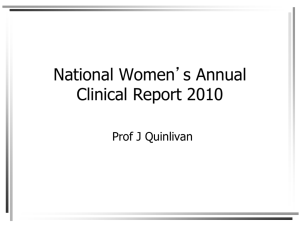
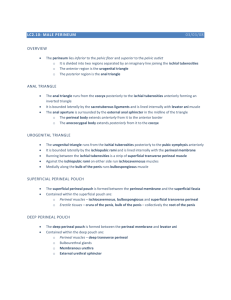
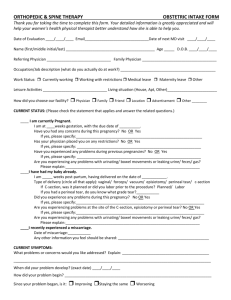
![Evidence based practices in Obstetrics [PPT]](http://s3.studylib.net/store/data/009501671_1-b25b29346ebdd5103c82dfac2b7e742e-300x300.png)
